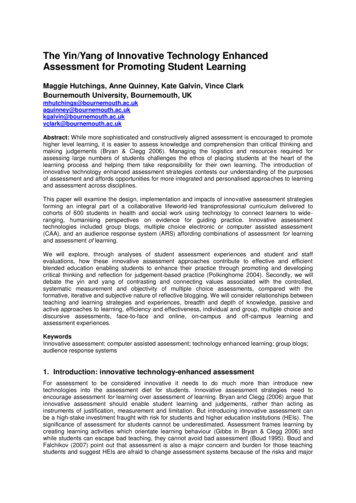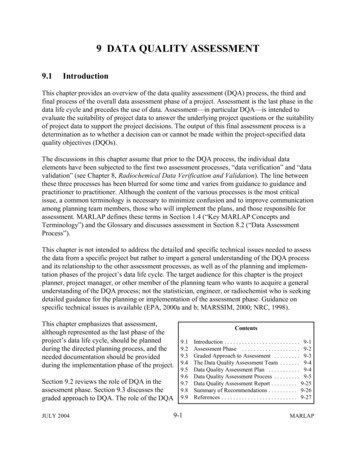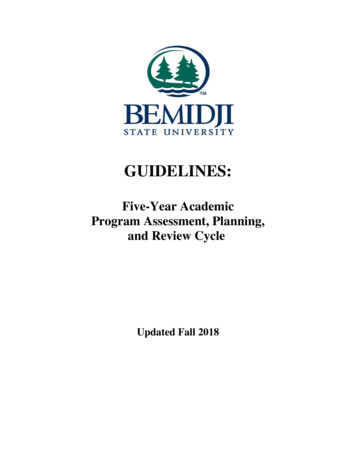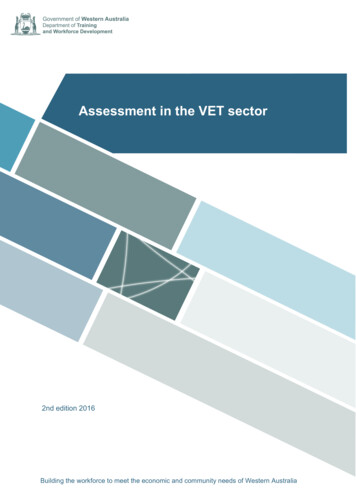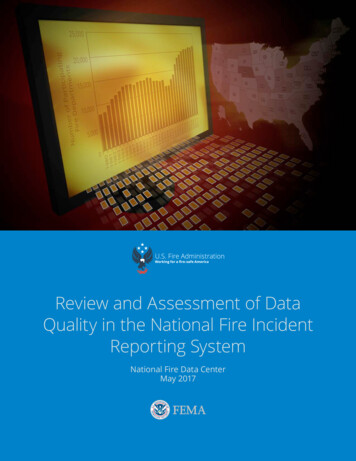
Transcription
Review and Assessment of DataQuality in the National Fire IncidentReporting SystemNational Fire Data CenterMay 2017
Mission StatementWe provide national leadership to foster a solid foundation forour fire and emergency services stakeholders in prevention,preparedness and response.
Review and Assessment ofData Quality in the NationalFire Incident Reporting SystemNational Fire Data CenterMay 20171This publication was originally submitted to the Office of Management and Budget in September 2014 andapproved in February 2016 as per the requirements of the Paperwork Reduction Act of 1995.1
Table of ContentsIntroduction.1About the National Fire Incident Reporting System. 3National Fire Incident Reporting System Enhancements. 7National Fire Incident Reporting System Training. 8Uses of the National Fire Incident Reporting System. 9The National Fire Incident Reporting System and the National Fire ProtectionAssociation Survey. 10Incident Reporting and Submission Process.Incident Reporting.Submission to the National Production Database.Public Data Release and Data Review.Data Quality and U.S. Fire Administration Interaction With States.Data Quality Checks by the National Fire Data Center.121213131515Key Data Considerations for the User.Unknown Entries.Fires Versus National Fire Incident Reporting System Record Counts.Counting Fires Versus Counting Fire-Related Statistics.Confined Versus Nonconfined Fires.Mutual Aid.Types of Fires.Property Definitions.Multiyear and Trend Analyses.Cause.Smoke Alarms and Smoke Alarm Performance.Dollar Loss Data.Structures, Buildings and Nonbuildings.17171717171818181819222222The National Fire Incident Reporting System Data Quality.State-Based Data Quality.Data Quality of Key Data Elements.The National Fire Incident Reporting System Data Element Quality.23232630National Fire Protection Association Survey.Sample Selection.Data Collection.Estimation Methodology.Fire Experience of Nonrespondents.7878797980Resources. 82Acronyms. 84Table of Contentsi
List of FiguresFigure 1. NFIRS Fire Department Participation 1980 to 2011, Fire Incidents Only.4Figure 2. Total Reported Fire Incidents, NFIRS Public Data Release 2003 to 2011.7Figure 3. NFIRS Incident Reporting, Submission and Dissemination Process. 14Figure 4. Three-Year NFIRS Data Quality by State Relative to National Average DataQuality Measure, 2009 to 2011. 24Figure 5. Annual NFIRS Data Quality by State Relative to National Average DataQuality Measure, 2009 to 2011. 25List of TablesTable 1. NFIRS Modules.5Table 2. NFIRS Fire Incident Data Reporting by Version (Percent).6Table 3. Midlevel Structure Fire Cause Groupings. 19Table 4. NFIRS Data Elements Used in USFA Analyses (Fires). 27Table 5. NFIRS Data Elements Used in USFA Analyses (Civilian Casualties). 30Table 6. Data Element Quality and Usability Summary for Common NFIRS DataElements Type of Fire, 2009 to 2011. 32Table 7. Data Element Quality and Usability Summary for Common NFIRS DataElements Type of Fire With Deaths or Injuries, 2009 to 2011. 33Table 8. Data Element Quality and Usability Summary for Common NFIRS DataElements Type of Casualty With Deaths or Injuries, 2009 to 2011. 34Table 9. Data Element Quality and Usability for Common NFIRS Data ElementsUsed in USFA Analyses Reported Nonbuilding Structure Fires, 2009 to 2011. 36Table 10. Data Element Quality and Usability for Common NFIRS Data ElementsUsed in USFA Analyses Reported Buildings and Mobile Property StructureFires, 2009 to 2011. 38Table 11. Data Element Quality and Usability for Common NFIRS Data ElementsUsed in USFA Analyses Reported Vehicle Fires, 2009 to 2011. 42Table 12. Data Element Quality and Usability for Common NFIRS Data ElementsUsed in USFA Analyses Reported Outside Fires, 2009 to 2011. 44Table 13. Data Element Quality and Usability for Common NFIRS Data ElementsUsed in USFA Analyses Reported Fatal Fires, 2009 to 2011. 46Table 14. Data Quality for Common NFIRS Data Elements Used in USFA AnalysesDistribution of Fatal Fires by Reported Deaths, 2009 to 2011. 49iiReview and Assessment of Data Quality in the National Fire Incident Reporting System
Table 15. Data Element Quality and Usability for Common NFIRS Data ElementsUsed in USFA Analyses Reported Buildings and Mobile Property StructureFatal Fires, 2009 to 2011. 50Table 16. Data Quality for Common NFIRS Data Elements Used in USFA AnalysesDistribution of Buildings and Mobile Property Structure Fatal Fires byReported Deaths, 2009 to 2011. 54Table 17. Data Element Quality and Usability for Common NFIRS Data ElementsUsed in USFA Analyses Reported Fires With Injuries, 2009 to 2011. 54Table 18. Data Quality for Common NFIRS Data Elements Used in USFA AnalysesDistribution of Reported Fires With Injuries by Reported Injuries, 2009 to 2011. 58Table 19. Data Element Quality and Usability for Common NFIRS Data ElementsUsed in USFA Analyses Reported Buildings and Mobile Property StructuresFires With Injuries, 2009 to 2011. 58Table 20. Data Quality for Common NFIRS Data Elements Used in USFA AnalysesDistribution of Buildings and Mobile Property Structure Fires With Injuries byReported Injuries, 2009 to 2011. 62Table 21. Data Element Quality and Usability for Common NFIRS Data ElementsUsed in USFA Analyses Distribution of Fires With Reported Property DollarLoss, 2009 to 2011. 63Table 22. Data Quality for Common NFIRS Data Elements Used in USFA AnalysesDistribution of Fires With Reported Contents Dollar Loss in Buildings andMobile Property Structure Fires, 2009 to 2011. 65Table 23. Data Element Quality and Usability for Common NFIRS Data ElementsUsed in USFA Analyses Reported Fire Deaths, 2009 to 2011. 66Table 24. Data Element Quality and Usability for Common NFIRS Data ElementsUsed in USFA Analyses Reported Fire Deaths in Buildings and MobileProperty Structures, 2009 to 2011. 69Table 25. Data Element Quality and Usability for Common NFIRS Data ElementsUsed in USFA Analyses Reported Fire Injuries, 2009 to 2011. 72Table 26. Data Element Quality and Usability for Common NFIRS Data ElementsUsed in USFA Analyses Reported Fire Injuries in Buildings and MobileProperty Structures, 2009 to 2011. 75List of Figures and Tablesiii
ivReview and Assessment of Data Quality in the National Fire Incident Reporting System
IntroductionFederal agencies conduct or sponsor a wide variety of information collections togather data from businesses, individuals, schools, hospitals, and state, local and tribalgovernments. Information collections that employ surveys are frequently used forgeneral-purpose statistics, as well as for program evaluations or research studies thatanswer more specific research questions. Data collected by federal agencies are widelyused to make informed decisions and to provide necessary information for policymakersand planners. The collection of this information can take many forms and is accomplishedin a variety of ways.The Paperwork Reduction Act of 1995 (PRA) requires agencies to submit requests to collectinformation from the public to the Office of Management and Budget (OMB) for approval.These requests, variously known as Information Collection Requests, PRA submissions, or“OMB clearance packages,” are required for any survey used for general purpose statistics,program evaluations or research studies. The purpose of the PRA is to ensure that thepublic is not overburdened by the federal data collection. In a given period, the OMB mayfocus on the design, methodology and practical utility of data to the federal governmentand other issues. In 2013, the OMB requested that the U.S. Fire Administration (USFA)assess and document the quality of the information from the National Fire IncidentReporting System (NFIRS) and the National Fire Protection Association (NFPA) and makeit more accessible and useable for NFIRS users. This document was originally completedand submitted to the OMB in September 2014 to fulfill the aforementioned request.Although NFIRS is by design a voluntary incident reporting system, and not a survey, theOMB considers the system to fall under the PRA. In the past, the OMB has questionedwhy the NFIRS is a voluntary census of incidents for all departments rather than astatistical sample. The USFA has investigated the possibility of sampling and the issuessurrounding it. While there are certain advantages to a statistical sampling methodology,the USFA has not undertaken a sampling approach to fire incident reporting for severalreasons. First and foremost, Public Law 93-498, the Federal Fire Prevention and ControlAct of 1974, directed the then newly created USFA to develop a standardized incidentdata reporting method and to assist local and state agencies in reporting incidentdata to this system. 2 Because the NFIRS is used at the local, state and federal levels,abandoning it for a statistical sampling method would adversely impact state and local firedepartment incident reporting and the NFIRS standard, which is also used internationally.Additionally, much of the cost burden of the current NFIRS reporting is carried by the statein conducting NFIRS operations. The USFA has relied heavily on states as cooperativepartners in bearing the costs and resources of maintaining the system, and the stateshave relied on the USFA to shoulder the development costs. Switching to a samplingmethod would mean the USFA would need to acquire additional funding and personnel todesign and maintain a new sampling system, leaving the state and local entities to whollycover the cost of an incident reporting system.http://uscode.house.gov/view.xhtml?req %28%22national fire data center%22%29&f treesort&fq true&num 1&hl true&edition prelim&granuleId USC-prelim-title15-section22082Introduction1
In addition to completing two separate studies showing that there is no evident systematicnonresponse bias to the NFIRS system, under the PRA process, the USFA has also madegood progress working with our state and local partners in addressing previous OMB PRAterms of clearance instructions to increase the use of the voluntary NFIRS system:“The agency is instructed to continue efforts to improve response rates to NFIRS.The agency should also investigate the possibility of using additional studies todetermine what characteristics of a fire department might make it less willing toparticipate in NFIRS and determine whether there is a systematic nonresponsebias to the system that should be disclosed in the published reports based on thissystem” (2003).“ The agency is instructed to continue efforts to increase the utilization ofNFIRS. The agency must provide a report to OMB on the bias in NFIRS due tononresponse. This report is a condition of future OMB approvals” (2006).“ The agency is instructed to continue efforts to increase the utilization ofNFIRS. The agency must provide a report to OMB on the bias in NFIRS due tononresponse. This report is a condition of future OMB approvals” (2009).The current terms of clearance require that:“ FEMA will engage in efforts over the clearance period to assess and documentthe quality of the information from NFPA and NFIRS and make this more accessibleand useable for NFIRS users” (2013).The following is a response, originally given in September 2014, to the 2013 Terms ofClearance. The response was made public in 2017. It is a review of the NFIRS system,the many robust data quality checks and mechanisms which are an integral part of thesystem, and an assessment of the data quality both at the state level and at the dataelement level. The data element assessment is of the most commonly used data elementsin the NFIRS data analyses. The NFIRS data from the three most recent years available atthe time of this document’s production (2009 to 2011) are reviewed. Although the USFAhas no authority over the NFPA survey, a section drawn from published NFPA documentscovering the NFPA survey methodology is also included.2Review and Assessment of Data Quality in the National Fire Incident Reporting System
About the National Fire IncidentReporting SystemThe NFIRS was established in 1975 as one of the first programs of the National FirePrevention and Control Administration, which later became the USFA. The basic concept ofthe NFIRS has not changed since the system’s inception. All states and all fire departmentswithin them have been invited to participate on a voluntary basis. Participating firedepartments report a common core of information on an incident and any casualties thatensue by using a common set of definitions. Detailed incident data are reported locally.Local agencies forward the completed NFIRS modules to the state agency responsiblefor the NFIRS data. The state agency combines the information with data from other firedepartments into a statewide database and then transmits the data to the National FireData Center (NFDC) at the USFA. Data on individual incidents and casualties are preservedincident by incident at local, state and national levels.From an initial six states in 1976, the NFIRS has grown in both participation and use. Overthe life of the system, all 50 states, the District of Columbia, and more than 40 majormetropolitan areas have reported to the NFIRS. More than 30,000 fire departments havebeen assigned participating NFIRS fire department identification numbers by their states.Once limited to fire incidents only, the NFIRS now encompasses all incidents to which thefire department responds: fire, Emergency Medical Services (EMS), hazardous materials(hazmat), and others.Approximately one million fire incident records and 22 million nonfire incident records areadded to the database each year. The NFIRS is the world’s largest collection of incidentsto which fire departments have responded.Between 1985 and 1999, the level of participation remained relatively constant: A fewstates came in or left the system each year, and at least 39 states reported to the NFIRS.Most years also included participation from the District of Columbia. The number of firedepartments participating within the states remained relatively constant as well, witha slight dip in participation during the system migration from version 4.1 to 5.0 in 1999.In 2000, the number of states increased to 43. The Department of Defense adopted theNFIRS reporting, and fire department participation began to bounce back from the version5.0 transition low. Since 2000, state and fire department participation has been steadilyincreasing. In 2003, the NFIRS reached a milestone with participation by all 50 states. Thefollowing year, the NFIRS achieved another significant goal: The NFIRS not only achievedthe national goal of 100 percent state participation, including the District of Columbia, butalso for the first time, the Native American Tribal Authorities submitted data.The NFIRS continues to grow and mature. As of 2007, a new level of participation hadbeen achieved: all 50 states, the District of Columbia, Native American Tribal Authorities,Northern Mariana Islands, and Puerto Rico all participated in the NFIRS for a total of54 state, district, tribal authority, and commonwealth entities. However, the NorthernMariana Islands and Puerto Rico are no longer reporting incident data to NFIRS. Firedepartments reporting fire incidents grew to 20,680 in 2011 (Figure 1). Across participatingentities, 69 percent of U.S. fire departments reported fire incidents to the NFIRS in 2011. 3The percentage of fire departments participating in the NFIRS varies from state to state,For 2011, NFPA estimated that there were 30,145 fire departments in the United States. NFPA, U.S. FireDepartment Profile — 2014, http://www.nfpa.org/ e-service/osfdprofile.pdf?la en, January 2016.3About the National Fire Incident Reporting System3
with some states not participating at all in some years. With over two-thirds of all firedepartments nationwide reporting fire incidents to NFIRS 5.0, the reporting departmentsrepresent a very large dataset that enables the USFA to make reasonable estimates ofvarious facets of the fire problem. Although some states do require their departments toparticipate in the state system, participation in the NFIRS is voluntary. Additionally, if afire department is a recipient of a Fire Act Grant, participation is required.4Figure 1. NFIRS Fire Department Participation 1980 to 2011, Fire Incidents 102011Number of ParticipatingFire Departments25,000Source: NFIRS.Note:1999 to 2008 includes participation from the NFIRS 4.1 and NFIRS 5.0 versions; 2009 and later includes participation onlyfrom the NFIRS 5.0.Corresponding to increased participation, the numbers of fires, deaths and injuries, as wellas estimates of dollar loss reported to the NFIRS, have also grown; an estimated 71 percentof all U.S. fires to which fire departments responded in 2011 were captured in the NFIRS.There are, of course, many problems in assembling a real-world database, and theNFIRS is no exception. Although the NFIRS does not represent 100 percent of incidentsreported to fire departments each year, the enormous dataset and good efforts by the fireservice result in a huge amount of useful information. Because of advances in computertechnology and data reporting techniques over the past 35 years, as well as improvementssuggested by participants, the NFIRS has been revised periodically. The newest revision,NFIRS 5.0, became operational in January 1999.The NFIRS 5.0 version captures information on all incidents, not just fires, to which afire department responds. In addition to many data coding improvements, version 5.0provides 11 modules that recognize the increasingly diverse activities of fire departmentstoday. These modules, together, contain 567 data elements or fields.From the Assistance to Firefighters Grant Guidance and Application Kit ( June 2012), if the applicant is a firedepartment, the department must agree to provide information, through established reporting channels, tothe NFIRS for the period covered by the assistance. If a fire department does not currently participate in theincident reporting system and does not have the capacity to report at the time of the award, the departmentmust agree to provide information to the system for a 12-month period that begins as soon as the departmentdevelops the capacity to report. See http://www.fema.gov/library/viewRecord.do?id 6007 (fy 2012 afgprogram guidance.pdf).44Review and Assessment of Data Quality in the National Fire Incident Reporting System
The Basic Module is the main module, which is completed for every incident. The othermodules are filled out, when appropriate, to provide additional information on an incident.All 11 modules are listed in Table 1:Table 1. NFIRS ModulesModuleDescriptionBasic ModuleGeneral information for each incidentFire ModuleFire incident informationStructure Fire ModuleInformation on structure firesCivilian Fire Casualty ModuleFire-related injuries or deaths to civiliansFire Service Casualty ModuleInjuries or deaths to firefightersEMS ModuleMedical incidentsHazardous Materials ModuleHazardous materials incidentsWildland Fire ModuleWildland or vegetation firesApparatus/Resources ModuleApparatus-specific informationPersonnel ModulePersonnel associated with apparatusArson ModuleIntentionally set fire informationSource: NFIRS.Data from the modules are grouped together each calendar year to create the Public DataRelease (PDR) files in delimited text format (.txt) that are then released annually into thepublic domain. For the NFIRS data submitted prior to 2012, the PDR files were releasedin dBase format (.dbf). The Apparatus/Resources and Personnel Modules are excludedfrom the PDR because they are intended for local fire department use only, and the PDRdataset’s main utility is intended for national analyses. The PDR files consist of a subsetof the data fields contained within the NFIRS national production database. For example,data elements with sensitive or identifying information are removed, as are data elementsthat are wholly used for maintenance or production purposes. The PDR data structurehas been considerably simplified from the production database’s schema for ease of use.The PDR files from 2004 to the present only include fire and hazmat incidents and theirrelated data tables. Prior to 2004, all incidents were included in the PDR files.In its basic form, the NFIRS PDR files have a relational data structure where data fromeach incident module is represented by a row in a data table. The primary tables (basicincident and incident address) contain most of the Basic Module data. There is exactlyone record in the basic incident table for every incident reported to the NFIRS. All othermodules, represented by data tables with similar names (such as fire incident or civiliancasualties), have records that are linked to the basic incident table through unique incidentidentification key fields (state, fire department ID, incident date, incident number andexposure number). Some module data are split across several tables (e.g., basic incident,incident address, and basic aid tables); one table (fire incident) combines data from twomodules (Fire Module and Structure Fire Module). Some tables, such as fire incident, willonly have one record for each relevant incident in the basic incident table, while tablessuch as civilian casualty may have several records linked to a single incident in the casewhere multiple injuries or deaths occur in the same incident.About the National Fire Incident Reporting System5
NFIRS 5.0, the current version of the NFIRS, is the result of a collaborative effort betweenthe USFA and state and local users. This version incorporates many improvements.The design of NFIRS 5.0 makes the system easier to use than previous NFIRS versionsbecause it captures only the data required to profile the extent of the incident. Somefires, for example, require just basic information to be recorded, whereas others requireconsiderably more detail.State participation is voluntary, and each state specifies the NFIRS reporting requirementsfor its fire departments. States have the flexibility to adapt their state reporting systemsto their specific needs. As a result, the design of a state’s incident reporting system variesfrom state to state. The NFIRS 5.0 version was designed so that data from state systemscan be converted to a single format that is used at the national level to aggregate andstore the NFIRS data.The proportion of 5.0 data has steadily increased since the introduction of NFIRS 5.0 in1999 (Table 2). The proportion of 5.0 data rose to 99 percent by the 2008 dataset. Prior to2009, the NFIRS 4.1 data in its converted form had been accepted by the system; however,the USFA only uses native 5.0 data in its NFIRS-based analyses and quality checks.5 Forthis reason, the USFA multiyear analyses do not include NFIRS 5.0 data prior to 2003, asprior to 2003 the proportion of 5.0 data in the NFIRS PDR was less than 80 percent. SinceJan. 1, 2009, NFIRS 4.1 data are no longer accepted by the system.Table 2. NFIRS Fire Incident Data Reporting by Version 0082009 — currentNFIRS 4.1, 5.0 format92774831191155210NFIRS 5.08235269818995959899100Source: NFIRS.Incidents submitted to the national database and reflected in the PDR declined initiallyas the NFIRS 4.1 acceptance was phased out, but increased as departments fully adoptedNFIRS 5.0. It is important to remember that the PDR is a one-time snapshot of the incidentdata submitted by the July 1 deadline. Additional data may be submitted to the nationaldatabase after this deadline.Although, beginning in 2009, the NFIRS does not accept version 4.1 data, a few future-dated NFIRS Version 4.1records from past years do appear in the database from user entry error; these records do not belong in thedata year in which they were submitted and should not be included in analyses.56Review and Assessment of Data Quality in the National Fire Incident Reporting System
Figure 2. Total Reported Fire Incidents, NFIRS Public Data Release 2003 to 2011Reported Fire Incidents1,400,0001,200,0001,000,0004.1 NFIRS Data800,0005.0 NFIRS Data600,000Total ReportedFire Incidentsin NFIRS PublicData 20102011Source: NFIRS.Note:Includes all incident records in the NFIRS PDR except those incidents with fatal data quality errors.National Fire Incident Reporting System EnhancementsUnder the USFA Reauthorization Act of 2008, the U.S. Congress authorized and fundedthe USFA to develop a web-based data entry tool enhancement to the NFIRS. This upgradeto the system began in October 2008. In 2010, a data warehouse for generating outputreports for use in analyses was developed with additional funding provided by Congressfor the NFIRS enhancements. These improvements make reporting and accessing theNFIRS data much easier for fire departments.In July 2010, the USFA completed and deployed the new web-based data entry tool. TheData Entry Browser Interface (DEBI) is a one-purpose tool for use by the fire service todocument incident information within the NFIRS. While the functionality is the same asthe NFIRS client Data Entry Tool that has been available for many years, DEBI allows entryof incidents using a standard web browser, eliminating the need to download, install andconfigure client software.The development of a flexible NFIRS data warehouse with comprehensive data minin
the many robust data quality checks and mechanisms which are an integral part of the system, and an assessment of the data quality both at the state level and at the data element level. The data element assessment is of the most commonly used data elements in the NFIRS data analyses. The NFIRS data from the three most recent years available at


